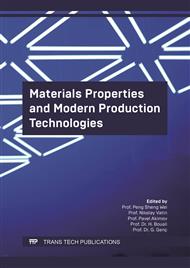[1]
Pronina Y.G. Analytical solution for decelerated mechanochemical corrosion of pres-surized elastic-perfectly plastic thick-walled spheres. Corrosion Science. 2015. Vol. 90. Pp. 161-167.
DOI: 10.1016/j.corsci.2014.10.007
Google Scholar
[2]
Arya V.K. Analytical and finite element solutions of some problems using a visco-plastic model. Computers and Structures. 1989. 33(4). Pp. 957-967.
DOI: 10.1016/0045-7949(89)90430-6
Google Scholar
[3]
Loghman A., Shokouhi N. Creep damage evaluation of thick-walled spheres using a long-term creep constitutive model. Journal of Mechanical Science and Technology. 2009. 23(10). Pp. 2577-2582.
DOI: 10.1007/s12206-009-0631-x
Google Scholar
[4]
Loghman A., Ghorbanpour Arani A., Aleayoub S.M.A. Time-dependent creep stress redistribution analysis of thick-walled functionally graded spheres. Mechanics of Time-Dependent Materials. 2011. 15(4). Pp. 353-365.
DOI: 10.1007/s11043-011-9147-8
Google Scholar
[5]
Cowper G.R. The elastoplastic thick-walled sphere subjected to a radial temperature-gradient. Journal of Applied Mechanics, Transactions ASME. 1960. 27(3). Pp. 496-500.
DOI: 10.1115/1.3644030
Google Scholar
[6]
Durban D., Baruch M. Analysis of an elasto-plastic thick walled sphere loaded by in-ternal and external pressure. International Journal of Non-Linear Mechanics. 1977. 12(1). Pp. 9-22.
DOI: 10.1115/1.3644030
Google Scholar
[7]
Parvizi A., Alikarami S., Asgari M. Exact solution for thermoelastoplastic behavior of thick-walled functionally graded sphere under combined pressure and temperature gradient loading. Journal of Thermal Stresses. 2016. 39(9). Pp. 1152-1170.
DOI: 10.1080/01495739.2016.1188614
Google Scholar
[8]
Chen Y.Z., Lin X.Y. An alternative numerical solution of thick-walled cylinders and spheres made of functionally graded materials. Computational Materials Science. 2010. 48(3). Pp. 640-647.
DOI: 10.1016/j.commatsci.2010.02.033
Google Scholar
[9]
Vestyak V.A., Tarlakovskii D.V. Unsteady axisymmetric deformation of an elastic thick-walled sphere under the action of volume forces. Journal of Applied Mechanics and Technical Physics. 2015. 56(6). Pp. 984-994.
DOI: 10.1134/S0021894415060085
Google Scholar
[10]
Sedova O. S., Pronina Y. G. Taking account of hydrostatic pressure in the modeling of corrosion of thick spherical shells. 2015 International Conference on Mechanics - Seventh Polyakhov's Readings. 2015, 7106771.
DOI: 10.1109/POLYAKHOV.2015.7106771
Google Scholar
[11]
Loghman A., Moradi M. The analysis of time-dependent creep in FGPM thick walled sphere under electro-magneto-thermo-mechanical loadings. Mechanics of Time-Dependent Materials. 2013. 17(3). Pp. 315-329.
DOI: 10.1007/s11043-012-9185-x
Google Scholar
[12]
Goldman A. Y. Predicting the deformation and strength properties of polymer and composite materials. Leningrad, Chemistry Publ., 1988, 272 p.
Google Scholar
[13]
Ogibalov P.M., Suvorov Yu.V. Mechanics of reinforced plastics. Moscow, Moscow State Univ. Publ., 1965, 479 p.
Google Scholar
[14]
Tarnopolsky Yu.M., Roze A.V. Specifics of calculating workpieces from reinforced plastics. Riga, Zinantne Publ., 1969, 264 p.
Google Scholar
[15]
Rabinovich A.L. Introduction to the mechanics of reinforced polymers. Moscow, Nauka Publ., 1970, 482 p.
Google Scholar
[16]
Sendeki J. (ed.). Mechanics of composite materials. Moscow, Mir, (1978).
Google Scholar
[17]
R. M. Christensen. Introduction to the mechanics of composites. Moscow, Mir Publ., 1982, 336 p.
Google Scholar
[18]
Pobedrya V.E. Mechanics of composite materials. Study guide for universities. Moscow, Moscow State Univ.Publ., 1984, 336 p.
Google Scholar
[19]
Kravchuk A.S., Mayboroda V.P., Urzhumtsev Yu.S. Mechanics of polymer and composite materials: Experimental and theoretical methods. Study guide for universities. Moscow, Nauka. Chief editorial board on physics-mathematics literature, 1985, 304 p.
Google Scholar
[20]
Voigt W. Lehrbuch der Kristallphysik. Berlin: Teubner. 1928. 962 s.
Google Scholar
[21]
Reuss A. Berechung der Fliessgrenze von Mischkristallen auf Grund der Plastizitats-bedingund Z. Angew. Math. UndMech. 1929. V 9. No. 1. Рр. 49-58.
DOI: 10.1002/zamm.19290090104
Google Scholar
[22]
Tyuryakhina T.P. Substantiation of the fundamentals of the theory of polymer composites additive structure formation after the principle of composite in composite,. Topical issues of Architecture and Construction engineering: proceedings of the Nineteenth International Scientific Conference. Editorial board. V.T. Erofeev (chief editor). Saransk, Mordovia State Univ. Publ., 2020, pp.299-301.
Google Scholar
[23]
Rybyev I.A. Constructional materials based on binding substances. Moscow, Vysshaya shkola Publ., 1969, 398 p.
Google Scholar
[24]
V.I. Solomatov, V.N. Vyrovoy. Physical features of the formation of the composite materials structure. Newletter of HEIs. Construction engineering and architecture,1984, No. 8, pp.59-64.
Google Scholar
[25]
Vyrovoy V.N., Dorofeev V.S., Sukhanov V.G. Composite materials and structures. Structure, self-organization, properties. Odessa, Odessa State Academy of Construction engineering and Architecture Publ., 2010. 169 p.
DOI: 10.31650/2415-377x-2020-79-63-69
Google Scholar
[26]
Bobryshev A.N., Erofeev V.T., Zharin D.E. Fundamentals of the formation of composite materials structure: monograph. Saransk, Mordovia State Univ. Publ., 2012, 120 p.
Google Scholar
[27]
Solomatov V.I. Bulk modules of a doubly-connected composite model. V.I. Solomatov, V.D. Cherkasov, A.S. Tyuryakhin, and Yu.V. Yurkin, Newsletter of HEIs. Construction engineering, Novosibirsk, 2001, No. 4, pp.43-48.
Google Scholar
[28]
Erofeev V.T., Tyuryakhin A.S., Erofeeva I.V. On the relations of the carrier phase's parameters with the effective parameters in models of granular composites. Structural theory and analysis of structures. 2018, No. 3, pp.7-17.
Google Scholar
[29]
Erofeev V.T., Tyuryakhin A.S., Tyuryakhina T.P. Flat Space of Bulk Module's Values in Granular Composites with Spherical Inclusions. International Journal of Civil Engineering and Technology. 2019; 10(8):333–342.
Google Scholar
[30]
Erofeev V.T., Tyuryakhin A.S., Tyuryakhina T.P. System of ordered subsets of bulk module's values in polydisperse composites with spherical inclusions. Newsletter of HEIs. Construction engineering. 2019. No. 6 (726). pp.5-17.
Google Scholar
[31]
Erofeev V.T., Tyuryakhin A. S., Tyuryakhina T. P., Tingaev A. V. Effective modules of two-phase construction composites with grain filler. Structural Mechanics of Engineering Structures and Buildings. 2019:15(6):407–414. http://dx.doi.org/10.22363/1815-5235-2019-15-6-407-414.
DOI: 10.22363/1815-5235-2019-15-6-407-414
Google Scholar
[32]
D.P. Gorsky, A.A. Ivin, A.L. Nikiforov. Concise dictionary of logic, Ed. by D.P. Gorsky. Moscow, Prosveshchenie Publ., 1991, 208 p.
Google Scholar


